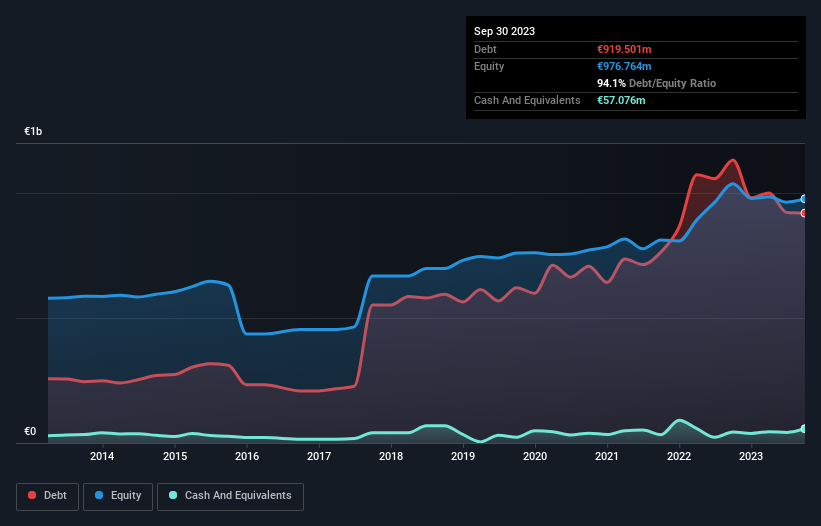- Greece
- /
- Metals and Mining
- /
- ATSE:ELHA
Elvalhalcor Hellenic Copper and Aluminium Industry (ATH:ELHA) Use Of Debt Could Be Considered Risky

Legendary fund manager Li Lu (who Charlie Munger backed) once said, 'The biggest investment risk is not the volatility of prices, but whether you will suffer a permanent loss of capital.' So it seems the smart money knows that debt - which is usually involved in bankruptcies - is a very important factor, when you assess how risky a company is. Importantly, Elvalhalcor Hellenic Copper and Aluminium Industry S.A. (ATH:ELHA) does carry debt. But is this debt a concern to shareholders?
Why Does Debt Bring Risk?
Debt and other liabilities become risky for a business when it cannot easily fulfill those obligations, either with free cash flow or by raising capital at an attractive price. Ultimately, if the company can't fulfill its legal obligations to repay debt, shareholders could walk away with nothing. However, a more common (but still painful) scenario is that it has to raise new equity capital at a low price, thus permanently diluting shareholders. Having said that, the most common situation is where a company manages its debt reasonably well - and to its own advantage. When we examine debt levels, we first consider both cash and debt levels, together.
View our latest analysis for Elvalhalcor Hellenic Copper and Aluminium Industry
How Much Debt Does Elvalhalcor Hellenic Copper and Aluminium Industry Carry?
As you can see below, Elvalhalcor Hellenic Copper and Aluminium Industry had €919.5m of debt at September 2023, down from €1.13b a year prior. However, because it has a cash reserve of €57.1m, its net debt is less, at about €862.4m.

How Healthy Is Elvalhalcor Hellenic Copper and Aluminium Industry's Balance Sheet?
Zooming in on the latest balance sheet data, we can see that Elvalhalcor Hellenic Copper and Aluminium Industry had liabilities of €670.5m due within 12 months and liabilities of €847.7m due beyond that. On the other hand, it had cash of €57.1m and €337.0m worth of receivables due within a year. So its liabilities total €1.12b more than the combination of its cash and short-term receivables.
Given this deficit is actually higher than the company's market capitalization of €863.1m, we think shareholders really should watch Elvalhalcor Hellenic Copper and Aluminium Industry's debt levels, like a parent watching their child ride a bike for the first time. Hypothetically, extremely heavy dilution would be required if the company were forced to pay down its liabilities by raising capital at the current share price.
We measure a company's debt load relative to its earnings power by looking at its net debt divided by its earnings before interest, tax, depreciation, and amortization (EBITDA) and by calculating how easily its earnings before interest and tax (EBIT) cover its interest expense (interest cover). This way, we consider both the absolute quantum of the debt, as well as the interest rates paid on it.
While Elvalhalcor Hellenic Copper and Aluminium Industry's debt to EBITDA ratio (4.8) suggests that it uses some debt, its interest cover is very weak, at 2.2, suggesting high leverage. It seems clear that the cost of borrowing money is negatively impacting returns for shareholders, of late. Even worse, Elvalhalcor Hellenic Copper and Aluminium Industry saw its EBIT tank 60% over the last 12 months. If earnings keep going like that over the long term, it has a snowball's chance in hell of paying off that debt. When analysing debt levels, the balance sheet is the obvious place to start. But you can't view debt in total isolation; since Elvalhalcor Hellenic Copper and Aluminium Industry will need earnings to service that debt. So when considering debt, it's definitely worth looking at the earnings trend. Click here for an interactive snapshot.
But our final consideration is also important, because a company cannot pay debt with paper profits; it needs cold hard cash. So it's worth checking how much of that EBIT is backed by free cash flow. Over the last three years, Elvalhalcor Hellenic Copper and Aluminium Industry recorded negative free cash flow, in total. Debt is usually more expensive, and almost always more risky in the hands of a company with negative free cash flow. Shareholders ought to hope for an improvement.
Our View
To be frank both Elvalhalcor Hellenic Copper and Aluminium Industry's conversion of EBIT to free cash flow and its track record of (not) growing its EBIT make us rather uncomfortable with its debt levels. And even its interest cover fails to inspire much confidence. Considering all the factors previously mentioned, we think that Elvalhalcor Hellenic Copper and Aluminium Industry really is carrying too much debt. To us, that makes the stock rather risky, like walking through a dog park with your eyes closed. But some investors may feel differently. When analysing debt levels, the balance sheet is the obvious place to start. However, not all investment risk resides within the balance sheet - far from it. These risks can be hard to spot. Every company has them, and we've spotted 4 warning signs for Elvalhalcor Hellenic Copper and Aluminium Industry (of which 1 is a bit unpleasant!) you should know about.
If, after all that, you're more interested in a fast growing company with a rock-solid balance sheet, then check out our list of net cash growth stocks without delay.
Valuation is complex, but we're here to simplify it.
Discover if Elvalhalcor Hellenic Copper and Aluminium Industry might be undervalued or overvalued with our detailed analysis, featuring fair value estimates, potential risks, dividends, insider trades, and its financial condition.
Access Free AnalysisHave feedback on this article? Concerned about the content? Get in touch with us directly. Alternatively, email editorial-team (at) simplywallst.com.
This article by Simply Wall St is general in nature. We provide commentary based on historical data and analyst forecasts only using an unbiased methodology and our articles are not intended to be financial advice. It does not constitute a recommendation to buy or sell any stock, and does not take account of your objectives, or your financial situation. We aim to bring you long-term focused analysis driven by fundamental data. Note that our analysis may not factor in the latest price-sensitive company announcements or qualitative material. Simply Wall St has no position in any stocks mentioned.
About ATSE:ELHA
Elvalhalcor Hellenic Copper and Aluminium Industry
Elvalhalcor Hellenic Copper and Aluminium Industry S.A.
Solid track record with excellent balance sheet.
Similar Companies
Market Insights
Community Narratives



